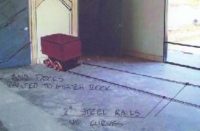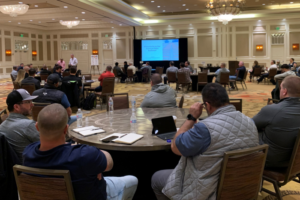The Europeans have beautiful stone and centuries of expertise — but now they’re fans of concrete too. “I’m blown away when countries like Greece and Italy — with some of the world’s most ingenious architecture — ask the DCI to come over to teach them how to use this artificial stuff,” says Bob Harris, president of the Decorative Concrete Institute in Temple, Ga.
Decorative concrete was developed in the United States, but it’s growing in popularity overseas. Artisans in Europe particularly have started to develop expertise, but people in Asia and South America are showing interest as well. This presents a big challenge when it comes to training and maintenance. Some American companies send their employees overseas to train new contractors, while others use international consultants for training. In March 2007, Harris partnered with a European distribution associate to open the DCI Europe Division and bring the complete package of training, products and technical support to the doorstep of European decorative concrete artists.
 The U.S. has long been the international leader in the development and promotion of decorative concrete, so it’s not surprising that the rest of the world turns to U.S. experts for their know-how. “Decorative concrete is still a new market overseas,” says Harris. “America is the innovator of the products and techniques. DCI outsources its training and consulting services overseas to Italy, Greece, Germany, and South Africa, just to name a few.”
The U.S. has long been the international leader in the development and promotion of decorative concrete, so it’s not surprising that the rest of the world turns to U.S. experts for their know-how. “Decorative concrete is still a new market overseas,” says Harris. “America is the innovator of the products and techniques. DCI outsources its training and consulting services overseas to Italy, Greece, Germany, and South Africa, just to name a few.”
When decorative concrete was first introduced overseas 10 to 15 years ago, those producing the product were not eager to share their expertise with foreign contractors. “Manufacturers used to be the only source of information,” says John Anderson, an area manager for Nevada, Arizona and Europe at Brickform in Rancho Cucamonga, Calif.
 That changed in recent years, and now those who spread their expertise around the world are a congenial bunch who are not fearful of foreign competition. People such as Harris, Mike Archambault of Moderne Methode, Marshall Barbash of Patterned Concrete and Matt Casto of Bomanite Group International helped the industry grow by sharing information, Anderson says. “If the inventor of the light bulb kept it to himself, we would all be living in the dark.”
That changed in recent years, and now those who spread their expertise around the world are a congenial bunch who are not fearful of foreign competition. People such as Harris, Mike Archambault of Moderne Methode, Marshall Barbash of Patterned Concrete and Matt Casto of Bomanite Group International helped the industry grow by sharing information, Anderson says. “If the inventor of the light bulb kept it to himself, we would all be living in the dark.”
It makes sense that the popularity of decorative concrete is on the rise globally, says Chris Forgey, marketing manager at Grace Construction Products in Cambridge, Mass. “It’s more cost-effective than mining natural materials, easier to work with, functional and timely when it comes to the length of time from beginning of construction to end,” he says.
 Of all the foreign markets, Europe is the furthest along in adopting decorative concrete. “In Europe, construction practices are more advanced than in the rest of the world,” says Forgey. “Europe is rich in aggregate, which is why exposed aggregate is most likely to be used as a resource for decorative construction in Europe.” He notes, however, that stamped concrete has not gone over well in Europe.
Of all the foreign markets, Europe is the furthest along in adopting decorative concrete. “In Europe, construction practices are more advanced than in the rest of the world,” says Forgey. “Europe is rich in aggregate, which is why exposed aggregate is most likely to be used as a resource for decorative construction in Europe.” He notes, however, that stamped concrete has not gone over well in Europe.
When it comes to training, there are a wide variety of solutions, but ultimately, the trend is toward shifting knowledge to local firms. “We do training in several countries, including China, Hong Kong, Japan, Singapore, Thailand, France and Italy,” says Clark Branum, director of technical services at Brickform. “Ideal Work offers training in Treviso, Italy, and American IT does training in Southeast Asia. Moderne Methode does training throughout France.”
Grace Construction also trains locals across the world. “Since Grace has offices around the globe, we have local people train in the art of decorative concrete and they become Grace employees,” says Grace’s Forgey. “And local companies then contract with Grace on many different (decorative concrete) projects.”
 People in foreign markets often mistakenly view concrete as similar to stone, which is vastly different when it comes to maintenance. “Maintenance is not a concept that is familiar to many countries, as they are used to using stone surfaces for finished areas,” says Brickform’s Branum. “Stone surfaces require very little maintenance as the surfaces are denser and in some cases highly polished. The perception is that concrete flooring requires the same amount of maintenance as stone floors, but that’s an incorrect assumption, as the concrete floors tend to require continual maintenance to keep them in good condition.”
People in foreign markets often mistakenly view concrete as similar to stone, which is vastly different when it comes to maintenance. “Maintenance is not a concept that is familiar to many countries, as they are used to using stone surfaces for finished areas,” says Brickform’s Branum. “Stone surfaces require very little maintenance as the surfaces are denser and in some cases highly polished. The perception is that concrete flooring requires the same amount of maintenance as stone floors, but that’s an incorrect assumption, as the concrete floors tend to require continual maintenance to keep them in good condition.”
Those working to spread decorative concrete globally have focused recently on building a market in Europe. “The next five years in Europe will be very interesting now that there are several high-quality manufacturers supported by some highly educated technical experts,” says Brickform’s Anderson. “In September I will return to Europe to help develop the market with what I’ve learned here in the U.S.”















